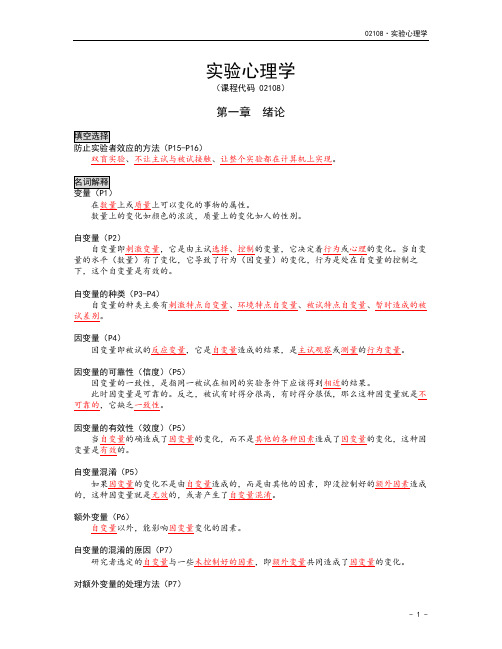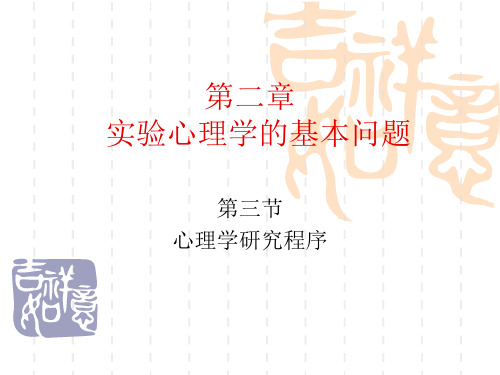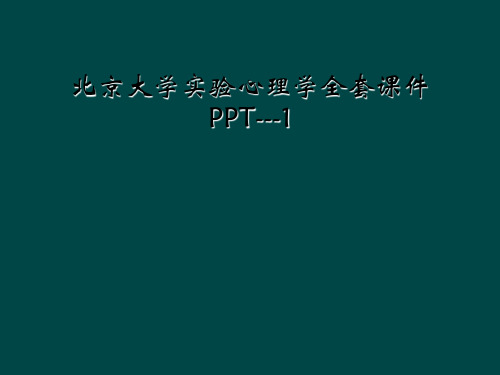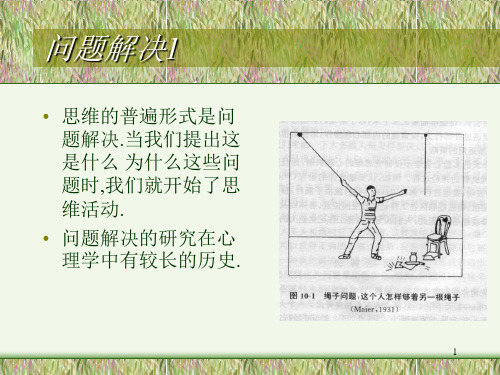北京大学实验心理学课件PPT版 第二章 实验设计
最新实验心理学电子课件-实验设计课件PPT

抵消实验条件的设计模式
抵消实验条件的设计示例
人们解决两个不同问题的思维特点分析
实验任务:分马问题和肿瘤问题
分马问题
如下图所示,栏内有九匹马,请画出两个 正方形将每一匹马分隔开。
肿瘤问题
假如你是个医生,面临一个胃部患恶性肿瘤的 病人,这个病人不能动手术,但如果不摧毁肿 瘤,病人会死掉。有一种射线可用来摧毁肿瘤, 但如果用高强度射线幅射肿瘤,肿瘤虽会被摧 毁,但这种高强度射线也会使肿瘤通道上的健 康组织受到损伤。强度较低的射线对健康组织 无害,但也不会摧毁肿瘤,用什么方式能使射 线摧毁肿瘤同时又避免伤害健康组织呢?
相同任务:如打靶;根据打靶成绩进行分组; 类似任务:如问题解决→不同种类问题解决; 相关任务:如智力测验→问题解决。
第二步,根据作业分数形成配对组。
配对设计的优缺点
优点:在实验处理之前,就把组间变异 缩到最小,并使各组内变异比单独的随 机分配更接近相等。因此,这种设计能 对被试个别差异给予更多的控制,小型 实验用配对设计,其效果比用随机分组 的效果更为显著。
被试间设计是要求每个被试(组)只接 受一个自变量的处理,对另一被试者 (组)进行另一种处理,故又称独立组 设计。
包括随机组设计和配对组设计。 被试间设计的统计检验——独立样本的
差异显著性检验。
1、随机组设计
将被试随机分配在不同的组内接受不同的自变 量处理。
随机组设计的基本假设是将被试随机分配到不 同的组,若对各组用同一样的课题,在系统的 条件下进行测量,其结果就成为系统组,则他 们的成绩在统计上应是相等的。
混合设计举例一
Johnson等(1983)用混合设计的方法 比较抑郁者和非抑郁者的记忆成绩。
实验前后设计评价
《实验心理学教案》课件

《实验心理学教案》PPT课件第一章:实验心理学概述1.1 实验心理学的定义介绍实验心理学的基本概念和研究方法解释实验心理学在心理学研究中的重要性1.2 实验心理学的历史发展回顾实验心理学的起源和发展过程介绍重要实验心理学家的贡献和实验研究1.3 实验心理学的研究方法解释实验设计的基本原则和类型介绍实验控制和实验变量的概念第二章:感知实验2.1 视觉感知实验介绍视觉感知的基本原理和实验方法分析经典视觉感知实验的结果和解释2.2 听觉感知实验介绍听觉感知的基本原理和实验方法分析经典听觉感知实验的结果和解释2.3 触觉感知实验介绍触觉感知的基本原理和实验方法分析经典触觉感知实验的结果和解释第三章:学习与记忆实验3.1 经典性条件反射实验介绍经典性条件反射的基本原理和实验方法分析经典经典性条件反射实验的结果和解释3.2 工具性条件反射实验介绍工具性条件反射的基本原理和实验方法分析经典工具性条件反射实验的结果和解释3.3 记忆实验介绍记忆的基本原理和实验方法分析经典记忆实验的结果和解释第四章:情绪与情感实验4.1 情绪理论概述介绍情绪理论的基本概念和理论观点分析情绪理论的实验研究和证据4.2 情绪实验介绍情绪实验的基本原理和实验方法分析经典情绪实验的结果和解释4.3 情感实验介绍情感实验的基本原理和实验方法分析经典情感实验的结果和解释第五章:认知实验5.1 注意实验介绍注意的基本原理和实验方法分析经典注意实验的结果和解释5.2 记忆与决策实验介绍记忆与决策的基本原理和实验方法分析经典记忆与决策实验的结果和解释5.3 问题解决与创造力实验介绍问题解决与创造力的基本原理和实验方法分析经典问题解决与创造力实验的结果和解释第六章:发展心理学实验6.1 发展心理学概述介绍发展心理学的基本概念和研究方法解释发展心理学在心理学研究中的重要性6.2 认知发展实验介绍认知发展的基本原理和实验方法分析经典认知发展实验的结果和解释6.3 情感与社会发展实验介绍情感与社会发展的基本原理和实验方法分析经典情感与社会发展实验的结果和解释第七章:心理测量学实验7.1 心理测量学概述介绍心理测量学的基本概念和研究方法解释心理测量学在心理学研究中的重要性7.2 心理测量工具与实验介绍常用心理测量工具及其实验方法分析经典心理测量实验的结果和解释7.3 心理测量学实验设计与分析介绍心理测量学实验设计的基本原则和方法讲解心理测量学实验数据的分析和解释方法第八章:心理病理学实验8.1 心理病理学概述介绍心理病理学的基本概念和研究方法解释心理病理学在心理学研究中的重要性8.2 心理疾病实验介绍心理疾病的基本原理和实验方法分析经典心理疾病实验的结果和解释8.3 心理治疗方法与实验介绍心理治疗方法的原理和实验方法分析经典心理治疗实验的结果和解释第九章:社会心理学实验9.1 社会心理学概述介绍社会心理学的基本概念和研究方法解释社会心理学在心理学研究中的重要性9.2 社会影响与行为实验介绍社会影响与行为的基本原理和实验方法分析经典社会影响与行为实验的结果和解释9.3 人际关系与群体动力实验介绍人际关系与群体动力的基本原理和实验方法分析经典人际关系与群体动力实验的结果和解释第十章:应用心理学实验10.1 应用心理学概述介绍应用心理学的基本概念和研究方法解释应用心理学在心理学研究中的重要性10.2 心理咨询与治疗实验介绍心理咨询与治疗的基本原理和实验方法分析经典心理咨询与治疗实验的结果和解释10.3 心理学在生活中的应用实验介绍心理学在生活中的应用原理和实验方法分析经典心理学在生活应用实验的结果和解释重点和难点解析1. 第一章实验心理学概述:理解实验心理学的基本概念和研究方法是学习后续章节的基础,特别是实验设计的基本原则和类型,实验控制和实验变量的概念。
实验心理学教案PPT课件

实验设计的核心在于实验控制,但是,在人为控 制创设的实验情景下得出的规律,其推论也往 往有相当的局限性。
与外部效度类似的另外一个概念: 生 态效度
一、实验设计的基本问题——实验中的效度
影响外部效度的因素: 1. 测验的反作用
教材上没有提到的其他影响实验内部效度 或外部效度的重要因素:
1. 实验处理的“传染”
假如实验组与控制组有机会相互沟通,实验组的被试 就可能把一些实验刺激的因素传递给控制组的被试。 例如,某学校在进行一项教师是否进行学习方法指导 对学生成绩影响的实验研究中,实验班和对照班的学 生可能会私下交流学习经验,得到学习方法指导的实 验班学生会把好的学习方法传播给对照班的学生。这 时候我们就说对照班受到了“污染”,已经不是真正的对 照班了。
例三:想知道一个人估计时间的准确性,设计 如下:一只绿色小灯泡和电子记时器相连,主 试按键让灯亮5秒、10秒、30秒、60秒,然后 让被试相应复制出按键时间。
效度反映的是对因变量的测量是否测 得到的是因变量自身真正代表的属性。
实例
在一项研究解题方法(自变量)对解题 能力影响的研究中,若以被试在一定时间内 解答出来的问题的多少为因变量的指标,当 要解答的问题足够多,而且按困难程度排列 时,以解答问题的数目作为因变量指标是有 效的。但是,如果问题很多但又都非常容易, 那么解答问题的数目作为因变量的指标就 不能说是有效的。因为它可能是由阅读速 度和书写速度造成的,而并不能准确地反映 出学生的解题能力。
一、实验设计的基本问题——实验中的效度
教材上没有提到的其他实验内部效度和外部效 度的重要影响因素:
2. 实验者或实验助理人员的偏向
《实验心理学》教案ppt课件

THANKS
感谢观看
数据推论性统计分析
参数估计 利用样本数据对总体参数进行估计, 包括点估计和区间估计。
假设检验
提出研究假设,通过计算统计量并查 表得到对应的P值,判断假设是否成 立。
方差分析
比较不同组别间均数差异的显著性, 分析因素对实验结果的影响。
回归分析
探讨自变量与因变量之间的线性关系, 建立回归方程并检验其显著性。
实验设计原则
对照原则、随机化原则、重复原则。
注意事项
选择合适的实验设计类型、明确实验目的和假设、控制实验误差、合理安排实 验顺序和时间、确保实验数据的准确性和可靠性。
03
心理实验方法与技术
观察法
定义
观察法是通过感官或辅助仪器,有目的、有计划地 对自然状态下发生的现象或行为进行系统、连续的 考察、记录、分析,从而获取事实材料的研究方法。
缺点
受观察者主观因素影响较大,观察结果难以量化, 且不易重复验证。
优点
简便易行,不妨碍被观察者的正常活动,能获得较 真实的第一手资料。
应用范围
适用于研究人类和动物的行为、心理活动、社会现 象等。
调查法
01
02
03
04
定义
调查法是通过各种途径,间接 了解被试心理活动的一种研究
方法。
优点
可以在短时间内收集大量资料, 效率较高;可以了解被试无法
直接观察的心理活动。
缺点
调查结果受被调查者主观因素 影响较大,且可能存在社会赞
许性效应。
应用范围
适用于研究人类的社会心理、 文化心理、教育心理等。
实验法
定义
优点
实验法是在人为控制条件下,操纵自变量、 观测因变量、控制额外变量,以探讨自变量 与因变量之间因果关系的研究方法。
北京大学实验心理学讲义

实验心理学(课程代码 02108)第一章绪论P15-P16)双盲实验、不让主试与被试接触、让整个实验都在计算机上实现。
在数量上或质量上可以变化的事物的属性。
数量上的变化如颜色的浓淡,质量上的变化如人的性别。
自变量(P2)自变量即刺激变量,它是由主试选择、控制的变量,它决定着行为或心理的变化。
当自变量的水平(数量)有了变化,它导致了行为(因变量)的变化,行为是处在自变量的控制之下,这个自变量是有效的。
自变量的种类(P3-P4)自变量的种类主要有刺激特点自变量、环境特点自变量、被试特点自变量、暂时造成的被试差别。
因变量(P4)因变量即被试的反应变量,它是自变量造成的结果,是主试观察或测量的行为变量。
因变量的可靠性(信度)(P5)因变量的一致性,是指同一被试在相同的实验条件下应该得到相近的结果。
此时因变量是可靠的。
反之,被试有时得分很高,有时得分很低,那么这种因变量就是不可靠的,它缺乏一致性。
因变量的有效性(效度)(P5)当自变量的确造成了因变量的变化,而不是其他的各种因素造成了因变量的变化,这种因变量是有效的。
自变量混淆(P5)如果因变量的变化不是由自变量造成的,而是由其他的因素,即没控制好的额外因素造成的,这种因变量就是无效的,或者产生了自变量混淆。
额外变量(P6)自变量以外,能影响因变量变化的因素。
自变量的混淆的原因(P7)研究者选定的自变量与一些未控制好的因素,即额外变量共同造成了因变量的变化。
对额外变量的处理方法(P7)消除、保持恒定。
自变量的交互作用(P11)如果一项有两个或两个以上自变量的实验里,一个自变量的效果,在另外一个自变量的每一水平上不一样。
主试(P14)主试就是实验者,即主持实验的人,他要向被试者交代任务,让被试者熟悉实验的要求。
他要向被试发出刺激,并通过实验收集实验的资料,即被试的反应。
被试(P14)被试就是实验对象,接受主试发来的刺激,并做出反应。
实验者效应(P15)主试者的态度对实验结果造成的影响。
《实验心理学》PPT课件

第二节 心思量表的建立
▪ 等级陈列法举例〔见P97〕 ▪ 某广告公司要对10张广告的优劣作评选,
请来了17名评判者〔即被试〕。评判的方 法是让被试将10张广告排成美到丑的一个 顺序。经过众多被试的比较,就可求出全 体被试对同一广告评判的等级的平均值, 这个值就是广告的平均等级。各广告按平 均等级排出的顺序就是一个顺序量表。
方法。此法的详细步骤是主试先呈现一个 规范刺激,例如,一个分量,并赋予规范 刺激一个客观值,例如为10,然后让被试 以这个客观值为规范,把其它不同强度比 较刺激的客观值,放在这个规范刺激的客 观值的关系中进展判别,并用数字表示出 来。然后计算出每组被试对每个比较刺激 量估计的几何平均数或中数,再以刺激值
▪ 例如,精神分裂症患者和正常人关于大小常性的 对照研讨:
第二节 心思量表的建立
▪ 伯雷斯等人以为精神分裂症患者比正常人的大小常性要高; ▪ 汉米尔顿等人那么以为精神分裂症患者比正常人的大小常
性要低; ▪ 皮什克姆-史密斯等人的看法以为他们彼此并没有差别。 ▪ 这些情况,以前总以为是实验条件和方法的不同呵斥的,
▪ 对数定律表示:心思量是刺激量对数的函 数,即当刺激以几何级数添加时,心思量 那么以算术级数添加。
▪ 这两个定律只适用中等强度的刺激。
第二节 心思量表的建立
▪ 二〕幂函数定律 ▪ 史文斯定律:指的是心思量S〔如长度的客
观单位〕是物理量I〔如线段的长度〕的幂 函数,用公式表示即S=bIa。其中b是由量 表单位决议的常数,a是觉得通道和刺激强 度决议的幂指数。幂函数的指数值决议了 按此公式所作心物关系曲线的详细外形。 这就是史蒂文斯提出的幂定律或称史蒂文 斯定律。
▪ 3.什么是比例量表?通常是怎样建立这种 量表?
实验心理学2.4 PPT课件

料错误?或作者的结果难以接受?其中的原因是 什么?重做实验结果会如何? 13.我如何解释这些结果? 14.从我对结果的解释中可以得到什么启发?
2019/11/21
9
第三节 心理学研究程序
第五,讨论与结论 15.作者在此是否一一回答了引言中的问题
的方法优于作者的吗?
7.作者的方法确实能够验证假设吗? 8.自变量是什么?因变量是什么? 9.研究者是怎样对额外变量进行控制的? 10.按照作者的方法,我预测实验的结果是
什么?
2019/11/21
8
第三节 心理学研究程序
第四,结果部分的阅读注意事项 11.研究者得到了哪些实验结果? 比较作者的结果和你对结果的预测。两者不同时
2019/11/21
24
第三节 心理学研究程序
三、确定实验控制(对变量分类和控制) 变量指在数量或者性质上可以变化的事物
的属性。在实验进行之前,要通过实验设 计对影响实验效果的各种因素进行控制。 一)选择、控制自变量
2019/11/21
25
第三节 心理学研究程序
1.自变量(刺激变量、独立变量)
3
第三节 心理学研究程序
心理学的实验研究程序就是实验的进程。 它是指实验在各个阶段应做的事情,它一 般包括五个基本程序:(P38)
确定研究课题 选择被试 确定实验控制 实验数据的收集、分析和综合 撰写实验报告
2019/11/21
4
第三节 心理学研究程序
一、确定研究课题(包括四个步骤) 一)选择课题 实际需要 理论需要 个人经验 前人的研究与文献资料
《实验心理学教案》课件

《实验心理学教案》PPT课件一、课程简介1. 课程目的:使学生了解实验心理学的基本概念、研究方法及其在心理学研究中的应用。
2. 课程内容:涵盖实验心理学的起源、实验设计、实验操作和数据分析等方面。
3. 课程安排:共10讲,每讲45分钟。
二、第一讲:实验心理学概述1. 讲义内容:介绍实验心理学的定义、起源和发展历程。
2. PPT设计:使用时间轴展示实验心理学的发展历程,插入实验心理学的相关图片,增强视觉效果。
三、第二讲:实验设计1. 讲义内容:讲解实验设计的基本原则,包括随机分组、控制变量等。
2. PPT设计:使用图表和案例来说明实验设计的原则,插入实验设计的流程图,便于学生理解。
四、第三讲:实验操作1. 讲义内容:介绍实验操作的基本步骤,包括实验准备、实验进行和实验记录等。
2. PPT设计:制作实验操作的步骤列表,插入实验操作的相关图片,使学生更容易掌握实验操作技巧。
五、第四讲:实验数据分析1. 讲义内容:讲解实验数据的统计分析方法,包括描述性统计、t检验等。
2. PPT设计:使用图表和实例来展示实验数据分析的方法,插入统计分析的公式和示例数据,帮助学生理解。
六、第五讲:实验心理学研究方法1. 讲义内容:详细介绍实验心理学中常用的研究方法,包括实验室实验、现场实验、调查实验等。
2. PPT设计:通过对比图表和实际案例,展示各种研究方法的特点和适用场景,增强学生的理解。
七、第六讲:实验心理学伦理1. 讲义内容:强调实验心理学研究中的伦理问题,包括知情同意、隐私保护等。
2. PPT设计:设计伦理问题的情景案例,引导学生思考和讨论,增强其伦理意识。
八、第七讲:实验心理学应用1. 讲义内容:介绍实验心理学在各个领域的应用,如教育、临床、商业等。
2. PPT设计:通过实际案例展示实验心理学的应用,让学生了解实验心理学在实际生活中的重要性。
九、第八讲:实验心理学案例分析1. 讲义内容:分析具体的实验心理学案例,让学生了解实验心理学研究的具体过程。
北京大学实验心理学全套课件PPT1

Applied research aims at solving a specific problem – such as how to cure bedwetting – whereas basic research has no immediate practical goal.
Are Experiments Too Far from Real Life?
实验心理学
第一章 引论
17
谢谢!
因变量的选择及测量 因变量的可靠性即信度 因变量的有效性即效度 因变量的敏感性
实验心理学
第一章 引论
14
五、实验中的各种变量(4)
额外变量或自变量混淆
有关变量(relevant variable):对因变量足 以产生影响的实验条件;
无关变量(irrelevant variable):对因变量 不产生影响的实验条件;
Hermann Ebbinghaus 艾宾浩斯
1850 - 1909
Wrote On Memory in 1885, showing complex mental phenomena could be studied
Barry H. Kantowitz, Henry L. Roediger Ⅲ & David G. Elmes, Experimental Psychology: Understanding Psychological Research, P466
Extended Weber’s law (Fechner’s law) and founded psychophysics
北京大学实验心理学课件版第二章实验设计

在教育学研究中的应用
实验设计在教育学研究中具有广泛的应用,通过实验可 以探究教育现象的本质和规律。
实验设计有助于发现新的教育方法和手段,提高教育质 量和效果。
实验设计能够控制实验条件,排除干扰因素,提高研究 的可靠性和准确性。
实验设计还可以用于评估教育政策和实践的效果,为教 育改革提供科学依据。
此外,还有一些特殊的实验设计方法,如因子设计、重复测量设计等,可以根据研究的具体需求进行 选择和应用。
02
实验设计的基本原则
随机化原则
随机化原则是指在实验中,实验对象应随机分 配到不同的实验组和对照组,以确保每个组别 的代表性,减少潜在的偏差和干扰因素。
随机化原则可以确保实验结果的一致性和可靠 性,提高实验的外部效度。
水平是实验设计的关键步骤。
确定实验设计类型
总结词
选择合适的实验设计方法
Байду номын сангаасVS
详细描述
根据研究目的和实验因素及水平,选择适 合的实验设计类型。常见的实验设计类型 包括随机对照实验、观察法、单被试实验 等。选择合适的实验设计方法能够有效地 控制实验误差,提高实验的内部效度和外 部效度。
确定实验对象和样本量
在社会学研究中的应用
实验设计在社会学研究中 具有重要的作用,通过实 验可以探究社会现象的本 质和规律。
实验设计有助于发现新的 社会学理论和方法,为社 会学发展提供支持。
ABCD
实验设计能够控制实验条 件,排除干扰因素,提高 研究的可靠性和准确性。
实验设计还可以用于评估 社会政策和实践的效果, 为社会改革提供科学依据 。
实验设计需要预先规划和描述,包括 实验的参与者、操作、测量和数据分 析等环节。
北京大学实验心理学全套课件PPT

三、问题解决的早期研究
• 功能固定化functional fixity • 定势set的作用 • 噪声
9
四、问题解决的计算机模拟
• 如果我们想了解被试在解决问题时头脑内发生的情况,则可以 用口语记录分析的方法,即出声思维的方法.这种方法就是让被 试在解决问题时说出头脑内进行的一切活动,予以记录,然后加 以分析.
• 口语记录分析法是认知心理学进行思维的计算机模拟收集经 验数据的方法.
• 认知心理学还假定,人是一个信息加工系统,信息加工系统也叫 符号操作系统,更常称作物理符号系统.计算机也是一个物理符 号系统.
• 将人脑比喻为计算机,就可以从一个已知的系统去加深对一个 不甚清楚的系统的理解.这样,我们可以用计算机程序来模拟人 的思维过程.
• 在上面的分布种,叉子和勺子之间没有共 同的关系,研究者称这样的回答是无效的
without valid answers.
19
一关系推理的研究5
• 心理模型理论 • 形式规则理论
20
二推理与工作记忆
• Baddeley1998曾指出,工作记忆的概念和智力的概念有 非常密切的联系.
• 工作记忆与语言理解、注意及推理有着密切的关 系,John Gabrieli等人运用fMRI技术在被试解决Raven推 理测验时扫描他们的脑区.结果发现额叶、顶叶和颞叶 皮层等脑区都有激活,而这些脑区正是空间、客体和言 语工作记忆进行时激活的脑区,Gabrieli认为推理似乎是 工作记忆能力的总和.
2
问题解决3
• 两个火车站相距100km,某天下午2点,两个火车头相向开出.一个火 车的速度为60km/h,另一个火车的速度为40km/h,当火车头开始行 走时,一只鸟突然出现在第一个火车头前面而向第二个火车头飞去, 当鸟到达第二个火车头时,它又立即以原来的速度向第一个火车头 飞去,鸟以80km/h的速度在两个火车头之间来回飞.问:在两火车 头相遇时鸟飞了多少公里
- 1、下载文档前请自行甄别文档内容的完整性,平台不提供额外的编辑、内容补充、找答案等附加服务。
- 2、"仅部分预览"的文档,不可在线预览部分如存在完整性等问题,可反馈申请退款(可完整预览的文档不适用该条件!)。
- 3、如文档侵犯您的权益,请联系客服反馈,我们会尽快为您处理(人工客服工作时间:9:00-18:30)。
实验心理学讲义
第二章 实验设计
5
随机组设计(2) (random groups design)
随机分配(random selection)
随机选择(random assignment)
实验心理学讲义
第二章 实验设计
2
一、独立组设计(1) (Independent Group Designs)
定义:就是把数目相同的被试分配到自变量的 不同水平或不同的自变量上。(each separate group in the experiment represents a different condition as defined by the level of the independent variable) 优点:一种自变量(或实验条件)不会影响另 一种自变量,因为每个被试只对一种自变量做 反应。
实验心理学讲义
第二章 实验设计
10
安慰剂控制(placebo effect)
Placebo effect: the improvement often shown in drug effectiveness studies when patients believe they have received a drug, although they have actually received an inert substance. The term comes from a Latin word meaning “to please,” and discovered by physicians.
拉丁方设计(Latin Square) 随机开始的循环排列 starting order with rotation)
(Random
实验心理学讲义
第二章 实验设计
17
完全组内设计(1)
(complete within-subjects design)
A type of within-subjects design in which practice effects are balanced by administering the conditions several times to each subjects such that results for each subject are interpretable.
实验心理学讲义
第二章 实验设计
4
随机组设计(1) (random groups design)
The most common type of independent groups design in which individuals are randomly selected or randomly assigned to each group such that groups are considered comparable at the start of the experiment.
实验心理学讲义
第二章 实验设计
6
随机组设计(3) (random groups design)
Loftus and Burns (1982) 实验目的:考察暴力场面对人的记忆的影响。 被试:226名University of Washington的自愿参加者;随机 分配到以下两组。 组一:看带有暴力场面的电影 组二:看非暴力场面的电影 看完电影之后,要求两组被试回答25道关于电影中事件的 问题。其中一道题非常关键:问被试在银行外面露天停车 场踢球的男孩穿的足球衫上的号码是多少。 因变量是正确回忆出男孩运动衫号码的人数的百分数。 结果:组一,4%;组二,28%。
实验心理学讲义
第二章 实验设计
18
完全组内设计(2)
(complete within-subjects design)
随机区组设计 (Block Randomization): the most common technique for carrying out random assignment in the random groups design; each block includes a random order of the conditions and there are as many blocks as there are subjects in each condition of the experiment.
心理学考研
基础学习:指定教材+配套教辅+网络班 强化训练:历年真题及详解+章节习题+专题突破 过关冲刺:全真试题详解+在线测试
中华心理学习网
实验心理学讲义 第二章 实验设计 1
第二章 实验设计
一、独立组设计 二、组内设计 三、混合设计 真实验设计 四、单组后测设计 五、单组前测后测设计 六、固定组比较设计 前实验设计 七、事后回溯设计 八、中断时间序列设计 九、质的评鉴与研究 准实验设计
实验心理学讲义
第二章 实验设计
20
随机区组设计(Block Randomization)举例(2)
给被试呈现如图所示的照片制成的幻灯片,要求被试利用 7点量表评价每一张幻灯片的情绪的强度。每次呈现一张 幻灯片,每张呈现10秒钟,然后给被试35秒钟进行评定。 实验中的自变量为照片的形式(左侧构成,原始照片,和 右侧构成),每位被试评价54张幻灯片:18张左侧构成照 片,18张原始照片和18张右侧构成照片。
O
R O
20
21 22
O
L L
29
30 31
L
R R
38
39 40
R
O O
47
48 49
L
O O
5
6 7
O
L R
14
15 16
L
R R
23
24 25
R
O R
32
33 34
L
O O
41
42 43
R
L R
50
51 52
R
L R
8
9
O
L
17
18
L
O
26
27
L
O
35
36
R
L
44
45
O
L
53
54
O
L
实验心理学讲义
实验心理学讲义
第二章 实验设计
7
匹配组设计(1) (matched groups design)
匹配被试就是对全部被试进行
预备测验,测验的性质与正式 实验的性质是类似的,或者说 是相关的,然后按测验成绩均 匀地形成组。
实验心理学讲义
第二章 实验设计
8
匹配组设计(2) (matched groups design)
实验心理学讲义
第二章 实验设计
11
实验者效应 (experimenter effects)
Experimenter effects: the experimenters’ expectations that may lead them to treat subjects differently in different groups or to record data in a biased manner.
ABBA平衡法 (ABBA Counterbalancing): a technique for balancing stageof-practice effects in the complete within-subjects design that involves presenting the conditions in one sequence followed by the opposite of the same sequence.
实验心理学讲义
第二章 实验设计
19
随机区组设计(Block Randomization)举例(1)
Sackheim,Gur和Saucy(1978)使用组内设计研究人的两侧面孔在情绪 表达强度上的差异。早期的研究者发现,被试能够准确地区分呈现给他 们的人类的6种基本情绪(快乐、惊奇、恐惧、悲伤、愤怒、和厌恶)的 照片。Sackheim和他的合作者利用一个人的一侧面孔和其镜像重新构成 一张完整的面孔的照片。上图为三种实验材料。
第二章 实验设计
22
随机区组设计(Block Randomization)举例(4)
实验心理学讲义
第二章 实验设计
3
一、独立组设计(2) (Independent Group Designs)
缺点:分配到各实验条件下的被试可能在 各方面不是等同的,如果是这样,那不同 实验条件造成的差异也可能是由于被试的 差别引起的。
克服方法:
随机组设计(random groups design) 匹配组设计(matched groups design)
实验心理学讲义
第二章 实验设计
16
克服方法
克服方法:
完全的组内设计(complete within-subjects design) 随机区组设计(block randomization) ABBA平衡法(ABBA counterbalancing) 不完全的组内设(incomplete within-subjects design) 所有可能的顺序(all possible orders) 选择的顺序(selected orders)
